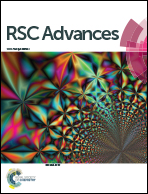Lipoprotein biosurfactant production from an extreme acidophile using fish oil and its immobilization in nanoporous activated carbon for the removal of Ca2+ and Cr3+ in aqueous solution
Abstract
Lipoprotein biosurfactant was produced from a lipid layer collected from fish processing wastewater (LLFWW) and was immobilized in functionalized nanoporous activated carbon (FNPAC) for sequestering the metal ions (Ca2+ and Cr3+) from aqueous solution. The maximum bio transformation of LLFWW into biosurfactant occurred in 96 h in a fermentation process using the acidophile, Bacillus subtilis. The mass of lipoprotein biosurfactant produced was 2.0 g per 7.0 g of LLFWW. The lipoprotein biosurfactant was immobilized in FNPAC and the immobilized capacity was 100 mg g−1 FNPAC. The biosurfactant immobilized FNPAC removed Cr3+ and Ca2+ from aqueous solution by 98.24% and 91.76% respectively. The morphology and functional group characteristics of lipoprotein biosurfactant bound metal ions were determined using scanning electron microscopy (SEM) and Fourier transform infrared spectroscopy (FT-IR) respectively. The sequestrated Ca2+ and Cr3+ in FNPAC matrix was confirmed using EDAX and EPR spectroscopy. The kinetic models for the sequestration of Cr3+ and Ca2+ by lipoprotein immobilized FNPAC were developed.


 Please wait while we load your content...
Please wait while we load your content...